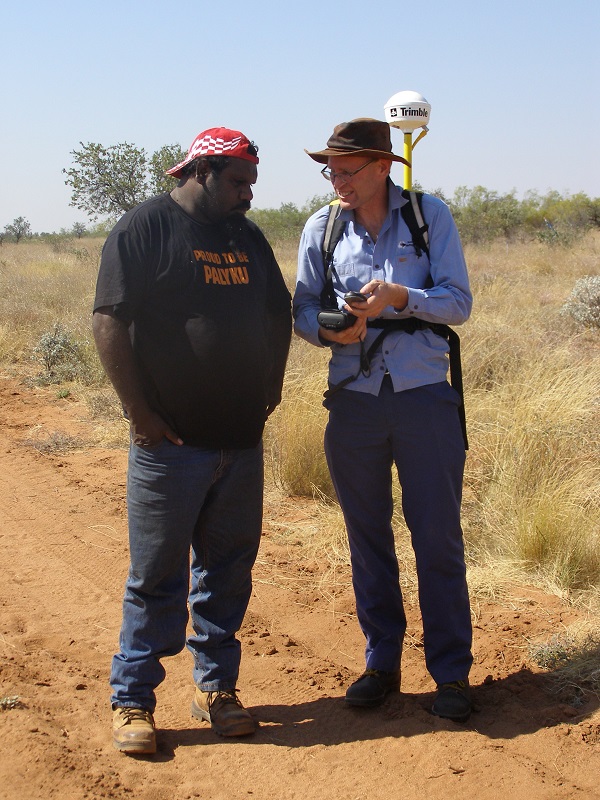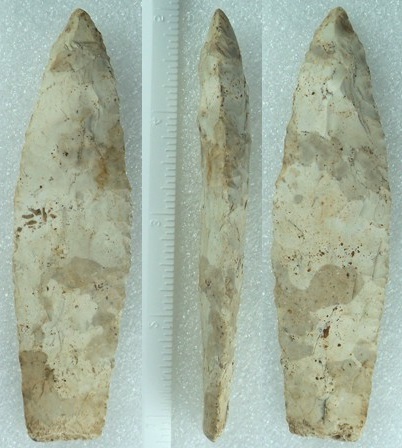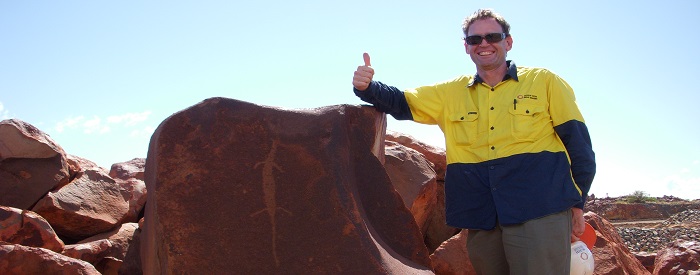
Phil Czerwinski of Perth, Australia and director of “Heritage Western Australia” an archaeological consultant company focusing on the survey of indigenous rock art, archaeological, and ethnographic sites in Western Australia came to learn about archaeology in southern Ontario. Phil arrived in Haldimand-Norfolk County July 4-11, 2014 to participate in an archaeological exchange with the Haldimand Norfolk Archaeological Regional Project (HNARP).
Phil was kind enough to take time from his schedule in Canada to answer a few questions about his experiences with archaeology in southern Ontario.
1. What kind of archaeology do you conduct in Western Australia?
I’m an archaeologist who does a lot of work in Western Australia. We have lots of cool archaeology such as artefact scatters, rock art, and caves with human occupation dating back 40,000 years ago. My main interest is in how hunter-gatherers use the landscape, and how these settlement patterns are shown in archaeological sites. Much of my work is for mining companies.
2. What interested you to come to Ontario and participate in this regional project?
I came to do fieldwork with the Haldimand Norfolk Archaeological Research Project (HNARP) in Ontario because Lorenz and I worked together in Australia a few years ago. He told me about his project and I thought it would be a great idea to see how things are done in Canada.
3. In Haldimand-Norfolk County much of the archaeology is conducted on private lands. When does your company deal with private land owners to access properties to conduct your archaeological work?
We do not do too much work on private lands as most of the work is on Crown Land, which is why I was interested in coming to see how HNARP relates to local landowners. What instantly impressed me during my time in the field with HNARP was the level of community engagement with the landowners and other stakeholders such as collectors. The way Lorenz Bruechert, Project Director spoke respectfully with them, listened to their concerns about accessing fields in crop, handling their precious artefact collections, and making sure the communication was a two way street was refreshing to experience. To have a beer and ‘talk turkey’ (in our case pigs) with landowners was wonderful. The fact that landowners and interested people get newsletter updates on HNARP is a great information sharing initiative.
4. HNARP attempts to develop long term relationships with land owners in an effort to develop community archaeology. When do consultant companies like Heritage Western Australia have an opportunity to develop community archaeology with their clients or within communities where development is planned?
Our archaeology is mostly mining based, so our relationships are with the companies and the Aboriginal groups on whose lands the mining companies want to mine. Often these turn into long term relationships, which have their ups and downs. We aim for sustainability in heritage; where we all get something out of the process.
5. How do corporations support community archaeology in Western Australia?
The main corporate interest in archaeology where I work is based on the approvals process, where heritage is often viewed as another box to check in the mining process. Some of the bigger mining companies do it differently, and sponsor larger regional studies in order to understand the Aboriginal heritage.

6. How do you see a regional archaeological study different or similar to how consultant archaeology is conducted in Australia?
There are long term goals in the type of regional study that HNARP is doing, whereas consultancy based archaeology often does not share this goal and is a get in and out quick approach to archaeology.
7. What benefits did you see in a regional study compared to consultant archaeology?
There are many benefits. By developing relationships with landowners HNARP can give something to the community that consultancy often does not – that being a sense of communal ownership and responsibility for regional heritage. It sheds light on large areas and hunter-gatherer settlement patterns across time and space.
8. The HNARP works collaboratively and in co-operation with land owners to engage them in public archaeology to protect archaeological sites and artifacts from destruction and permanent loss. What opportunities are there to conduct similar practices in for archaeological sites and artifacts in Australia?
Much of our work involves working with Aboriginal people and mining companies to manage archaeological sites for a win-win solutions. Mining takes up land, and archaeological sites are so prevalent in the Pilbara region of Western Australia where I work that this involves destroying sites. Here the aim is ensuring everyone is informed on what is going on, and when sites are to be destroyed they are done so in a culturally sensitive manner and in line with legislative requirements.
9. What finals comments would you like to share with Silo readers about your experiences with HNARP?
It is not easy to tell people about the ins and outs of archaeology in a way they can understand what you are trying to achieve, but being a local Lorenz understands the landowner’s issues and communicates in a down to earth manner. He works to develop long term relationships with landowners. This is rare in archaeology, be it in Australia or anywhere in the world. We have lots of stone artefact sites in Western Australia, although we do not have the nice artefacts such as arrowheads you folks have. To see these local treasures being studied in a project that is solely funded by the researcher is again uncommon.
Archaeology is archaeology anywhere in the world, but people are people. They have interests and issues that should never be over-ridden in the pursuit of academic studies. With the goal to put archaeology back into the community, HNARP is unique and deserves local support. After all, who best to understand the Haldimand-Norfolk area than an archaeologist who was raised and grew up a local farmer. Thanks for this opportunity to share my experiences about archaeology in southern Ontario. CP

The Hungarian National Museum and its Archaeological Department, as well as the Natural History Museum in Budapest, Hungary, have collections of materials dating back 400,000 years.
They keep hundreds and thousands of skulls that can help with adding pieces to the mosaic of the early human journey across the world. The Archaeological Museum in Zagreb, as well as the Neanderthal Museum in Krapina, both in Croatia,keep impressive anthropological collections. Even a small regional museum in Skrip on the Croatian Island of Brac, holds a collection which would put any Australian archaeological display to shame.
My delight at the opportunity to examine material forbidden in Australia was mixed with sorrow. I felt sorry for the generations of archaeology students in Australia.
Most of them literally never saw, nor touched, any real Australian prehistoric skull. Instead, most of the subjects they study relate to legal matters, political imperatives and instructions how to deal with Aboriginal tribes.
Some students can no longer tolerate this ideological tyranny and its appeasement policy. Instead of blindly accepting the APC paradigm, they are now turning to the old books, such as “The Passing of the Aborigines” by Daisy Bates (1938) and “Journals of two expeditions” by George Grey (1841), as well as more recent writings by Rhys Jones and John Mulvaney.
Tired of more than four decades of enforced single-mindedness and a worldview which is now crashing down, these fresh minds are rediscovering and embracing the tenets outlined by Dr Mulvaney in his appeal in 1991: “Outrage
[over repatriation policy] would extend far beyond the ranks of the ‘heritocracy’ should the French nationalist ‘owners’ re-bury the Cro-Magnon human remains or overpaint Lascaux, or if Ethiopians cremated ‘Lucy.’”
In view of the latest DNA research, those wise words are more important today than ever before. Note: This article is included in the Request to the Federal Government for an Inquiry into Aboriginal Industry Corruption, by Donald Richardson and [myself] Vesna Tenodi.
VESNA TENODI- archaeologist, artist, and writer based in Sydney, Australia.